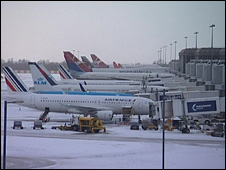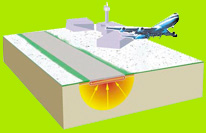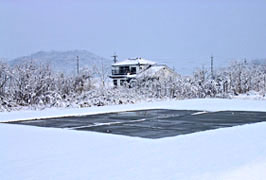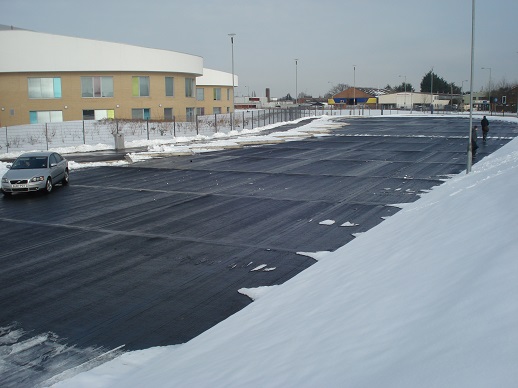ICAX™ Solar Runways provide heated runways for airports that can...
- de-ice runways, taxiways and aircraft parking stands
- ensure ice and snow free surfaces without the need for costly and time delaying mechanical treatments (snow ploughing, chemical spraying)
- stabilise the surface temperature to lessen wear and tear due to expansion and contraction
- increase the life of runways, reducing down time for surface replacement
- allow airports to operate without disruption in freezing conditions
- allow airports to operate without releasing chemical de-icing compounds into the environment
- improve winter resilience to ice and snow conditions
- prevent cancellations of flights, and diversion of flights to other airports
- help airports meet winter resilience targets with an effective snow plan
ICAX uses Interseasonal Heat Transfer to capture summer heat from Solar Runways and store the heat in ThermalBanks in the ground until heat is needed in winter to maintain Runway Systems above freezing point using a variant of underfloor heating.

Snow delays aircraft at Manchester Airport for seven hours on 20 December 2009
Ice closes runways at Heathrow, Gatwick
All BAA's London airport runways were closed in the first days of February 2009 by heavy snowfalls. Air traffic could have continued to flow if Heathrow, Gatwick, Stansted and Luton had used Interseasonal Heat Transfer to keep their runways clear of ice and snow.
Gatwick, Edinburgh and Southampton airports were also closed by snow and ice in the first days of December 2010.
BA cancels flights at Heathrow and Gatwick airports on Saturday 18 December 2010. Andrew Teacher, from Heathrow operator BAA, said it had invested more than £6m in the last year in technology to move snow and de-ice runways. More than £1.5m was spent on de-icing fluid alone last year, and Heathrow has storage for 500,000 litres of de-icing fluid.
BAA cancelled flights into Heathrow on Sunday 19 December 2010. BAA announced that its 200 aircraft parking stands were full and ice prevented the aircraft moving safely. The presence of aircraft on the stands inhibited chemical de-icing. BAA had hoped to clear the ice and open Heathrow on Monday 20 December.
On Monday 20 December it took longer than expected to clear ice and snow from the parking stands using traditional equipment. This delayed clearance of the two main runways. These knock-on effects delayed flights up until Christmas 2010. The cancellation of 4,000 flights in the week before Christmas led to the Heathrow Winter Resilience Enquiry.
Successful trial of Under Road Heating at Toddington Services
See the extended report by Transport Research Laboratories on the successful two year Toddington demonstration of Interseasonal Heat Transfer: TRL report on IHT for roads. Under Road Heating at Toddington is also featured in a BBC London News clip. To see video click on:
The Toddington demonstration was monitored over two years. For the whole of that time the surface of the road was maintained above the freezing point of water by circulating back to the road the heat that had been captured in summer through an array of pipes embedded in the surface. The same array of pipes was used to circulate heat back to the road in winter - the road did not freeze for two whole years, day or night.
Successful trial of Under Road Heating at Hiroshima
ICAX Solar Road Systems clear snow and ice using under road heating
Ice hazards on airport runways, taxiways and parking stands
The chief hazard to aircraft on icy airport runways is lack of friction: the runway may not be long enough if the aircraft cannot use its brakes efficiently. The second danger comes from corrosion which is exacerbated by the potassium based runway de-icers used to clear the runways and parking stands. A third danger of de-icing chemicals is the adverse environmental impact on the local environment and local water courses.
Under Runway Heating clears all of these dangers by using environmentally friendly renewable energy at a low annual running cost.
De-icing aircraft parking stands using Solar Runway Systems
ICAX under runway heating maintains an aircraft parking stand above freezing point. This is an effective technique of anti-icing to prevent ice forming on the parking stand. De-icing is required if ice has been allowed to form on the surface and much greater energy is needed to de-ice the surface after ice has been allowed to form and adhere to the surface.
Solar Runway Systems can be used in airports as an effective method for aircraft stand snow removal and ice control.
ICAX has worked closely with pavement engineers and airside construction companies to ensure the structural integrity of the parking stands as well as controlling the thermal performance at the surface.
Interseasonal Heat Transfer
The primary function of Interseasonal Heat Transfer is to heat and cool buildings without burning fossil fuels by means of exploiting Ground Source Energy and ThermalBanks.
ICAX Solar Road Systems clear snow and ice using under road heating
See Deicing airport runways with Interseasonal Heat Transfer.
Green Heat | Green Cooling | Green Energy Options | Thermal Energy Storage





